

Creative Writing Lesson Plans: Week One
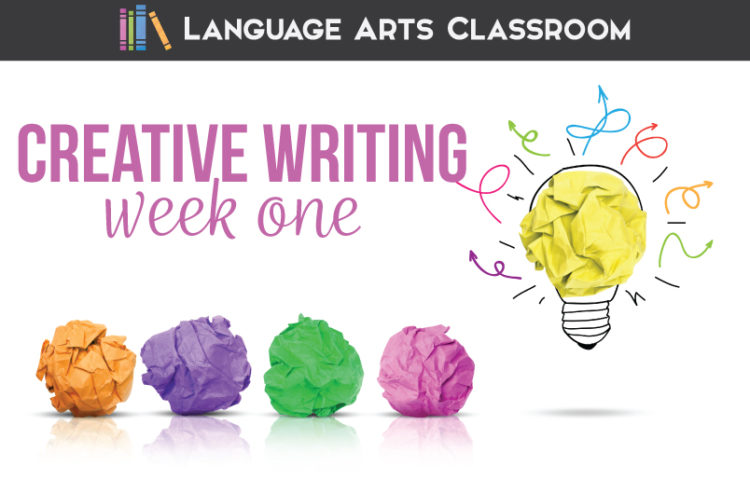
Looking for creative writing lesson plans? I am developing creative writing lesson ideas!
I’ve written and revamped my creative writing lesson plans and learned that the first week is vital in establishing a community of writers, in outlining expectations, and in working with a new class.
What are some good creative writing exercises?
Some good creative writing exercises include writing prompts, free writing, character development exercises, and fun writing games.
The first week, though, we establish trust—and then we begin powerful creative writing exercises to engage young writers and our community.
How can add encouragement in creative writing lesson plans?
I’ve found students are shy about writing creatively, about sharing pieces of themselves. A large part of the first week of class is setting the atmosphere, of showing everyone they are free to create. And! These concepts will apply to most writing lesson plans for secondary students.
Feel free to give me feedback and borrow all that you need! Below, find my detailed my day-by-day progression for creative writing lesson plans for week one.

Creative Writing Lesson Day One: Sharing my vision
Comfort matters for young writers. I’m not a huge “ice breaker” type of teacher—I build relationships slowly. Still, to get student writing, we must establish that everyone is safe to explore, to write, to error.
Here are some ideas.
Tone and attitude
For day one with any lesson plan for creative writing, I think it is important to set the tone, to immediately establish what I want from my creative writing students. And that is…
them not to write for me, but for them. I don’t want them writing what they think I want them to write.
Does that make sense? Limitations hurt young writers. My overall tone and attitude toward young writers is that we will work together, create and write together, provide feedback, and invest in ourselves. Older kiddos think that they must provide teachers with the “correct” writing. In such a course, restrictions and boundaries largely go out the window.
Plus, I specifically outline what I believe they can produce in a presentation to set people at ease.
The presentation covers expectations for the class. As the teacher, I am a sort of writing coach with ideas that will not work for everyone. Writers should explore different methods and realize what works for them. First, not everyone will appreciate every type of writing—which is fine. But as a writing community, we must accept that we may not be the target audience for every piece of work.
Therefore, respect is a large component of the class. Be sure to outline what interactions you find acceptable within your classroom community.
Next, as their writing coach, I plan to provide ideas and tools for use. Their job is to decide what tools work for their creative endeavors. My overall message is uplifting and encouraging.
Finally, when we finish, I share the presentation with students so they can consult it throughout the semester. The presentation works nicely for meet-the-teacher night, too!
After covering classroom procedures and rules, I show students a TED Talk. We watch The Danger of a Single Story by Chimamanda Adichie. My goal is to show students that I don’t have a predetermined idea concerning what they should write. This discussion takes the rest of the class period.
Establishing comfort and excitement precedents my other creative writing activities. Personalize your “vision” activities for your lessons in creative writing. Honestly, doing this pre-work builds relationships with students and creates a positive classroom atmosphere.
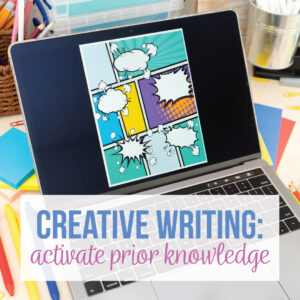
Creative Writing Lesson Day Two: Activating prior knowledge
Students possess prior knowledge concerning creative writing, but they might not consider that. Students should realize that they know what constitutes a great story. They might not realize that yet. An easy lesson plan for creative writing that will pay off later is to activate prior knowledge. Brainstorm creative, memorable, unforgettable stories with students. Share your thoughts too! You will start to build relationships with students who share the same tastes as you (and those that are completely different!).
Activation activity
During this activity, I want to see how students work together, and I want to build a rapport with students. Additionally, activating prior knowledge provides a smooth transition into other creative writing activities.
This creative writing activity is simple:
I ask students to tell me memorable stories—books, play, tv shows, movies—and I write them on the board. I add and veto as appropriate. Normally doing these classroom discussions, we dive deeper into comedies and creative nonfiction. Sometimes as we work, I ask students to research certain stories and definitions. I normally take a picture of our work so that I can build creative writing lessons from students’ interests.
This takes longer than you might think, but I like that aspect. This information can help me shape my future lessons.
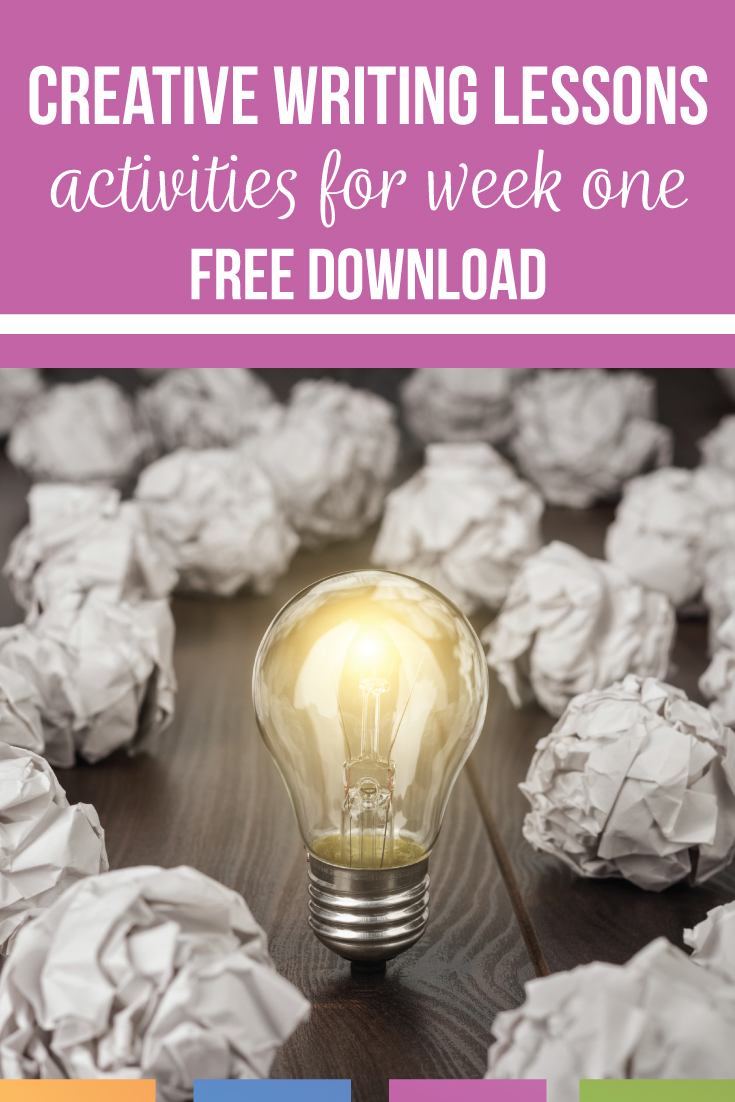
With about twenty minutes left in class, I ask students to form small groups. I want them to derive what makes these stories memorable. Since students complete group and partner activities in this class, I also watch and see how they interact.
Students often draw conclusions about what makes a story memorable:
- Realistic or true-to-life characters.
- Meaningful themes.
- Funny or sad events.
All of this information will be used later as students work on their own writing. Many times, my creative writing lessons overlap, especially concerning the feedback from young writers.
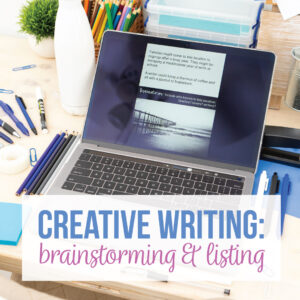
Creative Writing Lesson Day Three: Brainstorming and a graphic organizer
From building creative writing activities and implementing them, I now realize that students think they will sit and write. Ta-da! After all, this isn’t academic writing. Coaching creative writing students is part of the process.
Young writers must accept that a first draft is simply that, a first draft. Building a project requires thought and mistakes. (Any writing endeavor does, really.) Students hear ‘creative writing’ and they think… easy. Therefore, a first week lesson plan for creative writing should touch on what creativity is.
Really, creativity is everywhere. We complete a graphic organizer titled, “Where is Creativity?” Students brainstorm familiar areas that they may not realize have such pieces.
The ideas they compile stir all sorts of conversations:
- Restaurants
- Movie theaters
- Amusement parks
By completing this graphic organizer, we discuss how creativity surrounds us, how we can incorporate different pieces in our writing, and how different areas influence our processes.

Creative Writing Lesson, Days Four and Five: Creative Nonfiction
Students need practice writing, and they need to understand that they will not use every word they write. Cutting out lines is painful for them! Often, a lesson plan for creative writing involves providing time for meaningful writing.
For two days, we study and discuss creative nonfiction. Students start by reading an overview of creative nonfiction . (If you need mentor texts, that website has some as well.) When I have books available, I show the class examples of creative nonfiction.
We then continue through elements of a narrative . Classes are sometimes surprised that a narrative can be nonfiction.
The narrative writing is our first large project. As we continue, students are responsible for smaller projects as well. This keeps them writing most days.
Overall, my students and I work together during the first week of any creative writing class. I encourage them to write, and I cheer on their progress. My message to classes is that their writing has value, and an audience exists for their creations.
And that is my week one! The quick recap:
Week One Creative Writing Lesson Plans
Monday: Rules, procedures, TED Talk, discussion.
Tuesday: Prior knowledge—brainstorm the modeling of memorable stories. Draw conclusions about storytelling with anchor charts. Build community through common knowledge.
Wednesday: Graphic organizer.
Thursday and Friday: Creative nonfiction. Start narrative writing.
Students do well with this small assignment for the second week, and then we move to longer creative writing assignments . When classesexperience success with their first assignment, you can start constructive editing and revising with them as the class continues.

These creative writing activities should be easy implement and personalize for your students.
Would you like access to our free library of downloads?
Marketing Permissions
We will send you emails, but we will never sell your address.
You can change your mind at any time by clicking the unsubscribe link in the footer of any email you receive from us, or by contacting us at [email protected] . We will treat your information with respect. For more information about our privacy practices please visit our website. By clicking below, you agree that we may process your information in accordance with these terms.
We use Mailchimp as our marketing platform. By clicking below to subscribe, you acknowledge that your information will be transferred to Mailchimp for processing. Learn more about Mailchimp’s privacy practices.
Are you interested in more creative writing lesson ideas? My Facebook page has interactive educators who love to discuss creative writing for middle school and high school creative writing lesson plans. Join us!

creative writing creative writing activities
- Try for free
Creative Writing Lesson Plans
- Most Popular
- Most Recent

Walking by the Way
the road to inspired learning
Eight Free Creative Writing Lessons
February 17, 2012 by Ami 17 Comments
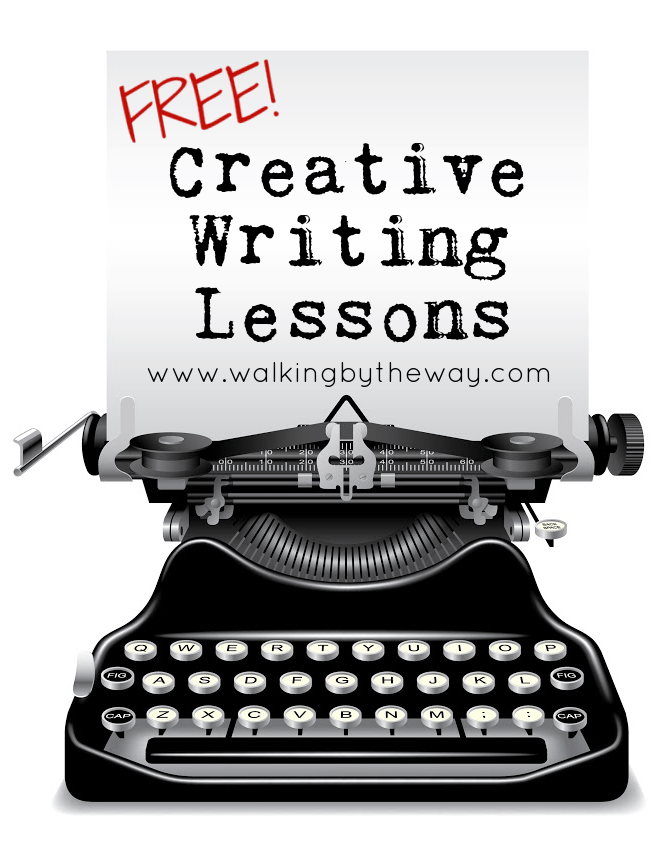
I know I throw around the word favorite all the time. But this is the truth: teaching creative writing lessons is my favorite.
I have taught creative writing enrichment for summer school students. I have taught creative writing in various homeschool settings and co-ops. I have taught big students and little students. And I love it.
Since I love to share homeschool co-op class ideas , I have compiled the creative writing lessons from a co-op class that I taught.
Creative Writing Lessons for a Homeschool Co-op Class
First, please remember that any teacher can use these creative writing lessons. You don’t need to be teaching homeschoolers. You can be a classroom teacher or a homeschool teacher at home with one student. You can even be a librarian who needs a fun program series.
Second, I used these creative writing lesson plans with upper elementary students (with maybe a few 7th graders thrown in). However, you can adapt and use them for older students or younger students!
Creative Writing Lesson Plans
Creative writing lesson one.
The first lesson focuses on cliché and metaphor. It prompts students to consider how words matter.
Grab lesson one here .
Creative Writing Lesson Two
The second lesson teaches students about sensory details: why they are important and how to include them in their writing. Students will begin using sensory details to evoke smells and sounds and sights.
Grab lesson two here.
Creative Writing Lesson Three
The third lesson introduces showing vs. telling. Students learn how to recognize authors who utilize showing, and students are able to articulate the difference between showing and telling.
Grab lesson three here.
Creative Writing Lesson Four
The fourth lesson teaches students how to capture images. We use examples of poetry and prose to discuss this important writing skill.
Grab lesson four here.
Creative Writing Lesson Five
The fifth lesson introduces the story elements of character and conflict.
Note: You may choose to split this lesson into two lessons since it covers two big elements. I only had nine weeks with my students, so I had to jam character and conflict together.
Grab lesson five here.
Creative Writing Lesson Six
The sixth lesson introduces the students to point of view and perspective. We have fun reading poems and using pictures to write descriptions from different points of view.
Grab lesson six here.
Creative Writing Lesson Seven
The seventh lesson puts everything we’ve learned together. I read the students some fractured fairy tales, and we watch some, too. Students then use the prewriting activities and their imaginations to begin drafting their own fractured fairy tales.
Grab lesson seven here.
Creative Writing Lesson Eight
The eighth lesson focuses on revision. After a mini-lesson, students partner up for peer editing.
Grab lesson eight here .
For our final class day, students bring revised work, and I host coffee shop readings. This is a memorable experience for students (and their teacher).
Creative Writing Lessons FAQ
Since posting these creative writing lessons, I have had lots of questions. I decided to compile them here in case you have the same question.
Q: What are copywork quotes? A: Copywork quotes are simply great quotes that students copy as part of their homework assignments. You can use any quotes about writing. I’ve included my favorites throughout the printable packs.
Q: Can I use this with a younger or older student? A: Absolutely! Just adapt it to meet the needs of your student.
Q: Can I use this for my library’s programming or my homeschool co-op class? A: Yes! I just ask that it not be used for profit.
Do you have any questions about teaching creative writing? What’s your biggest hang-up when it comes to teaching creative writing? I’d love to hear from you and help you solve the issue.

January 7, 2016 at 1:57 pm
Hi Theresa,
As long as you are not profitting from using them, they are yours to use! Enjoy! Wish I could be there to help facilitate all those young writers!
[…] Creative Writing Class […]
Leave a Reply Cancel reply
Your email address will not be published. Required fields are marked *
Save my name, email, and website in this browser for the next time I comment.
How to Effectively Teach Creative Writing in Elementary
Today let’s discuss how to effectively teach creative writing at the elementary level. Creative writing is such an important writing skill to teach students from a young age. Young writers need to understand the concept of creative writing as using their imagination to express themselves freely through words.
It’s not just about proper grammar and spelling (though those are important too!) , but rather about sparking their creativity , allowing them to dream up unique characters , exciting adventures, and incredible worlds. By nurturing their storytelling abilities early on, we’re not just helping them become better writers, but also fostering their confidence, encouraging self-expression, and igniting a lifelong love for writing. So, let’s dive into some strategies and tips to make your creative writing lesson plans a hit in your elementary classroom!

What is Creative Writing?
Creative writing is essentially writing in which the author uses his or her imagination to create a story. Creative writing in simple terms refers to the process of expressing thoughts, ideas and stories in a unique and imaginative way.
It’s about letting children’s minds wander freely, encouraging them to use their imagination to create characters, settings, and plots. Creative writing isn’t just about grammar and spelling; it’s about fostering a love for storytelling, allowing kids to explore their creativity, and helping them find their voice through words on paper. It’s a journey that encourages self-expression, builds confidence, and nurtures a lifelong appreciation for writing. The whole purpose of creative writing is to think outside the box and stray from traditional structures and norms.
Creative writing falls under one of the 5 categories of writing but it also combines a lot of these styles together:
- Narrative Writing
- Descriptive Writing
- Persuasive Writing
- Expository Writing
- Creative Writing
Creative Writing Lesson Plans Don’t Have to Be Difficult
Finding creative ways for students to write using their imaginations doesn’t have to be difficult. No matter the grade level, creative writing lessons should offer plenty of opportunities for students to tell their point of view on a subject. Don’t let creating lesson plans for creative writing be a headache! It’s all about giving kids the chance to let loose and share their thoughts in their own special way.
Whether they’re in 2nd grade, 3rd grade, or 5th grade, the key is to let their imagination run wild. Get them talking about what interests them, throw in some fun prompts, and watch the magic happen! Mix things up with different writing styles – stories, poems, even real-life tales. Make it a safe space where they feel free to jot down whatever comes to mind. By balancing a bit of structure with loads of creative freedom, teaching creative writing becomes a blast for both the teachers and the students!

Here’s How to Teach a Creative Writing Activity to Elementary Students:
1. start with creative writing prompts.
One of the first activities you can try is using writing prompts with students. Writing prompts are a great tool to get students’ brain juices flowing, no matter if they are elementary, middle school, or high school students! Coming up with writing topics for younger students can be especially challenging sometimes.
Inside the How to Write a Paragraph Year-Long Bundle there are specific writing prompts that are scaffolded and differentiated to meet all learner’s needs. You will find everything you need inside this resource to help your students who struggle with writing understand how to write a paragraph all YEAR LONG … trust us! It allows for easy planning for your writing lessons because it’s got different seasonal writing resources and prompts inside no matter what time of year it is. These are the perfect place to start to get your students writing based on themes.
Once they are comfortable in this category, then it’s time to actually get them to come up with some of their own ideas to write about now (after all that is the ENTIRE point of a creative writing lesson!)
Try with these juicy writing prompts below to help get your student’s creativity flowing if they need help coming up with a topic to write about :
- Personal memories: “Tell about someone who taught you something really important.”
- Imaginative scenarios: “Let’s create a wild story set in a world where anything goes!”
- Prompts based on a familiar mentor text: “What if your favorite book ended differently? Give it a new twist!”
- Lead-in sentences: “I saw myself in the mirror and couldn’t believe what I saw. Overnight, I…”
- Fascinating or thought-provoking images with a directive: “Who do you think calls this log cabin home? Tell us their story and what they’re up to!”
2. Break Down the Prompts Together
Do NOT rush this next step! We need to make sure our students are coming up with unique and creative writing ideas. During this first week’s lesson plan, you want to make sure students know exactly what they are getting themselves into with the creative writing process. Make it known that these prompts above are to help guide them and their imagination. Help to break down what each prompt is asking/ looking for:
For example, if the prompt says “I saw myself in the mirror and couldn’t believe what I saw. Overnight, I…,” then what questions should the students be asking?
Hopefully, they will tell you they want to know what they look like in the mirror right now.
Then you can have students think of 5 possible situations for what happened and how they look.
3. Do a 5 Minute “Free Write Brain Dump”
During the next step of a creative writing lesson plan, encourage students to do a brain dump in their writing journals on all of their prior knowledge on the subject that they will be writing about. This lets you know a couple of things as the teacher: Do they have their own experience on this topic and enough background knowledge? Does the subject areas that they are free-writing about make sense for the creative writing topic? This should only take about 5 minutes and you are NOT worried about spelling or grammar during this step.
For example: if they are planning to write about the solar system but they don’t have much to say during this free write brain dump, this is where you may want to incorporate a mini lesson or guided conference with you to make sure they are picking a topic that they have a lot of background knowledge about or can at least figure out where to find the answers they might need for their writing.
The “free write brain dump” is helpful for students to see a couple of things- okay I know enough information about this topic and am ready to organize my thoughts OR I had a hard time just coming up with random thoughts to write about…maybe I need a need a new topic. It will truly help decide their confidence factor for this assignment.

4. Start Your Planning Process
The next step in your creative writing unit should be having students take their decided-upon creative writing topic and organize their thoughts and ideas. This step is super important because you want the information to be in the students’ own writing but you also want to make sure they have a plan for how to get their point across. Your stronger writers may be ready to go but some may need a bit more structure set up to help them.
There are a couple of different ways they can organize their ideas:
Use Graphic Organizers
Graphic organizers are the perfect thing to use if students want to stick with a paragraph-type writing structure. For your lower writers, this might be the way to go because graphic organizers make planning a lot easier and the structure makes it super easy to follow. Graphic organizers also help break down the writing process into chunks so it doesn’t feel like such a difficult task to students who may struggle more with their writing skills or for ESL students.
Character Development Worksheets
Provide worksheets that prompt students to describe the characters in detail that they want in their story. Include sections for physical appearance, personality traits, motivations, and character arcs. This helps students develop well-rounded characters before they start writing.
Peer Brainstorming
Organize small group brainstorming sessions where students can share their ideas and receive feedback from their peers. This way can totally help students polish up their ideas and come up with fresh new ones for their creative writing.

Story Boarding
Encourage students to create a visual storyboard for their story. They can draw a series of pictures or scenes that outline the plot, helping them visualize the sequence of events in their narrative. We really love this idea for planning for students who are learning English as a second language and students who have more difficulties communicating their thoughts out loud.
Voice Recording
Finally, one last idea: If your students are feeling unsure about writing things down, suggest they talk it out and record their thoughts on a device such as a classroom iPad.
They might be amazed at how easily their spoken words turn into great written stuff on the page! This is another favorite of ours for those students who struggle with getting their thoughts on paper or are learning English as a second language.
During the planning phase , it is a good time to take the opportunity to do any mini lessons you feel needed with students on any of the skills above.
5. Write the Rough Draft
Next is taking the creative narrative and putting it into a rough draft version using their planning method. It’s time for them to start coming up with their own creative short story. Do they have a main character? Is there a problem and solution? Does the writing make sense? After the rough draft, it can be super beneficial to meet with students individually or in small groups to give feedback before they move forward on the final copy.
Word of advice: Don’t worry about spelling or grammar too much in the rough draft phase! Just help students get their thoughts out onto paper!
6. Time To Write the Final Draft
As the creative writing journey nears its conclusion, it’s time to guide your students toward the crucial phase of crafting their final drafts. This stage marks a shift towards independent work, where students take ownership of refining their narratives. Encourage them to enrich their stories with vibrant sensory details to help bring the writing to life.
This isn’t just about polishing; it’s about infusing their words with emotions and imagination. The final draft represents all of their hard work! Make sure you help them reach their fullest potential with their creative writing and storytelling skills!
A Final Word on Teaching Creative Writing to Elementary Students
When planning your creative writing lesson plans for the school year, it’s best to think about the overall entire writing process. For students that you KNOW creative writing will be a challenge for, take some time during English language arts sessions and work with them on the simple structures of writing to help build their confidence. If they struggle with the mechanics and confidence to write, they honestly may not be ready for the creative writing process just yet. Use the resource below to help them refine their writing skills so that all of your students can be a confident and creative writer!

How do you feel about creative writing lesson plans?
You might also like:.
FREE Differentiated Creative Writing Prompts for Fall
Excuse our digital dust! We’re busy renovating this website to make it even more fabulous. Stay tuned!
- Read more about: Writing
You might also like...
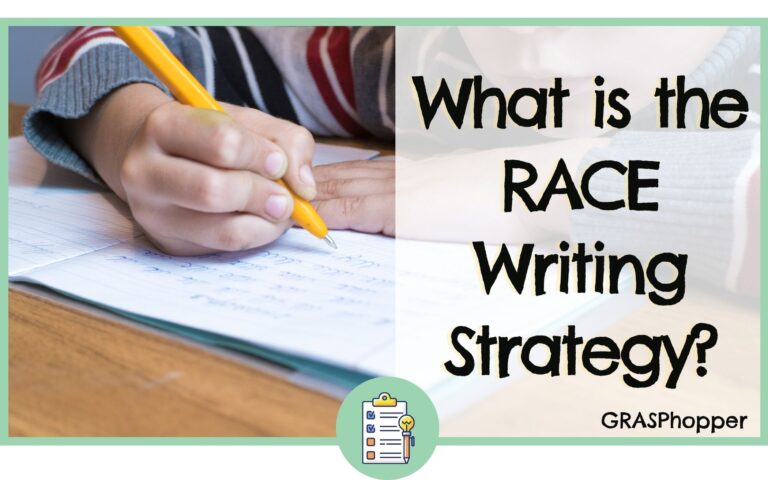
What is the RACE Writing Strategy?

The Best Paragraph Writing Worksheets for 5th Grade
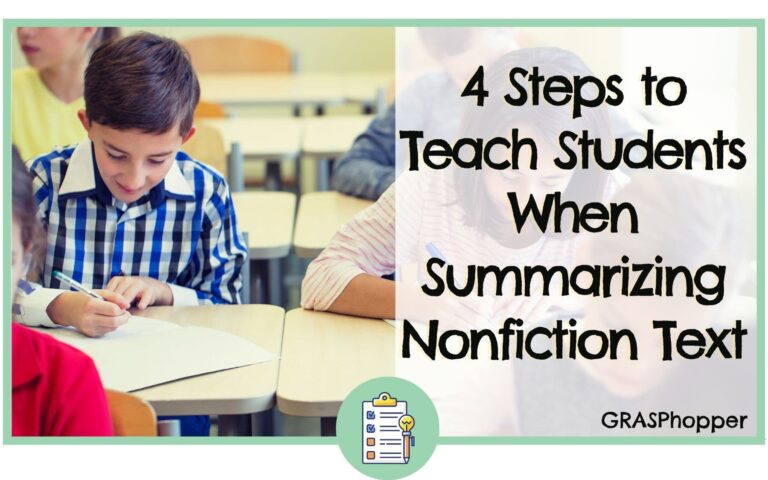
4 Steps to Teach Students When Summarizing Nonfiction Text
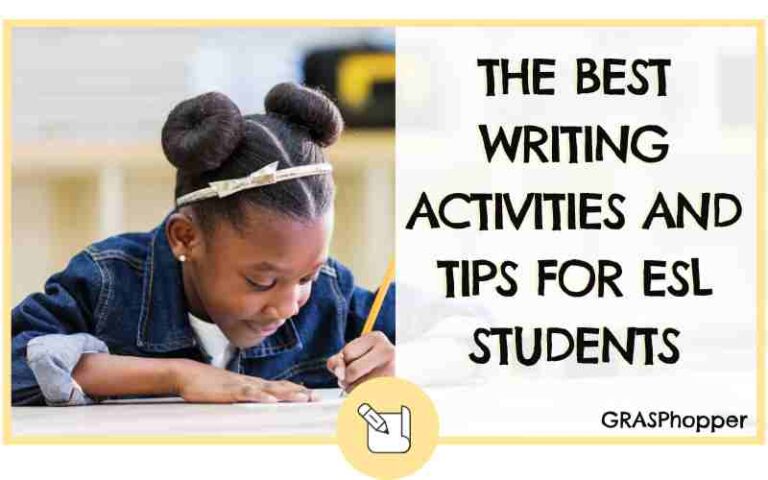
The Best Writing Activities and Tips for ESL Students
Teach smarter, not harder join the newsletter.
Transform your teaching with our teaching tips, resources, and freebies delivered straight to your inbox!

The Goodies
© GRASPhopper Learning • Website by KristenDoyle.co
- How to write a story
- How to write a novel
- How to write poetry
- How to write a script
- How to write a memoir
- How to write a mystery
- Creative journaling
- Publishing advice
- Story starters
- Poetry prompts
- For teachers
How to Teach Writing - Resources for Creative Writing Teachers
Fiction writing course syllabus with lesson plans, fiction writing exercises and worksheets, resources for teaching introductory poetry writing, resources for teaching children.

How to teach writing - general thoughts
- help students to understand the elements of craft (e.g., story structure, poetic meter, etc.) so that they can recognize them in their reading and consciously experiment with them in their writing.
- open students' eyes to the options available to them when they write a story or poem (e.g., "showing" instead of "telling", using different kinds of narrators and narrative viewpoints, using different poetic forms).
- encourage students to become close observers of the world around them and to find creative material in their environments.
- teach students the value of specificity, of using all five senses to discover details that may not be obvious to the casual observer.
- help students to separate the processes of writing and editing, to avoid self-criticism while writing their rough drafts to allow ideas to flow freely (for this to work, their teachers also have to avoid criticizing rough drafts!). Teach students to treat self-editing as a separate stage in the writing process.
- get students reading in the genre they'll be writing; e.g., if they're writing poetry, encourage them to read a lot of poems.
- help students learn to trust their own perspectives and observations, to believe that they have something interesting to say.
- teach students not to wait for inspiration, that they can write even when not inspired.
- get students excited about writing!
© 2009-2024 William Victor, S.L., All Rights Reserved.
Terms - Returns & Cancellations - Affiliate Disclosure - Privacy Policy
Creative Writing Lesson Plans: From Paragraphs to Narratives
Return from Creative Writing Lesson Plans to Creative Writing Ideas and Activities
Would you prefer to share this page with others by linking to it?
- Click on the HTML link code below.
- Copy and paste it, adding a note of your own, into your blog, a Web page, forums, a blog comment, your Facebook account, or anywhere that someone would find this page valuable.
Helping You Write Across the Curriculum!
copyright 2009-2013 www.creative-writing-ideas-and-activities.com
- Writing Topics
- Writing Prompts
- Writing Ideas
- Writing Activities
- Lesson Plans
- Writing Tips
- Privacy Policy
Our Most Popular Pages
1. Teaching Resources
2. How to Write a Myth
3. February Writing Prompts
4. How to Write a Legend
5. Writing a Personal Narritive
6. Writing Fables
7. Writing Mystery Stories
8. Math Prompts
9. Science Writing Prompts
10. Elements of Persuasive Writing
Recommeded Resources:
AnyWord(TM) Spelling Practice Series!
Worksheets, games and activities to use with any spelling words. Three volumes in all!
Download yours today!
Stop Essay Pain!
LitWorks.com
Resources to help students prepare for literature examinations.
Teach Kids Drama!
Creative Writing in the Natural World: A Framing

- Resources & Preparation
- Instructional Plan
- Related Resources
To promote development, detail, and focus of ideas in students' writing, it sometimes helps to start with a fun, creative writing activity that encourages what you want to see in all of their writing. In this minilesson, students practice writing detailed, sensory-rich descriptions by framing a small piece of nature and freewriting about it. From this, students can develop a variety of types of writing including poetry, short stories, science writing, reflections, and other academic genres.
Featured Resources
- Literal vs. Figurative Language Guide
- Internet access and the Flip Book Interactive
From Theory to Practice
This lesson explores figurative language comparisons formally known as simile and metaphor; however, the focus of the lesson is on students' use of their their imaginations to describe their observations in writing rather than on the official terminology for language use. In Wondrous Words: Writers and Writing in the Elementary Classroom , author Katie Wood Ray advises, "Give it [the craft element you identify in a text] a name so you can refer to it easily in the future as you study craft and as you writing your own texts"; yet the name that students use need not be the formal, "correct" name (42). The formal name of the element simply detracts from the ways that writers work. As Ray explains, "What's important is that, in seeing it and naming it for yourself, you have a new vision of what's possible when you try to write well" (42). When we do use formal names for craft elements, best practice pairs such words with students' definitions of the elements. Ray and Lisa Cleaveland say, "We are careful to use the words most writers in the world use for the important concepts of writing . . . if we embed kid-friendly explanations of what they mean...we need not shy away from the words themselves" (98). Further Reading
Common Core Standards
This resource has been aligned to the Common Core State Standards for states in which they have been adopted. If a state does not appear in the drop-down, CCSS alignments are forthcoming.
State Standards
This lesson has been aligned to standards in the following states. If a state does not appear in the drop-down, standard alignments are not currently available for that state.
NCTE/IRA National Standards for the English Language Arts
- 5. Students employ a wide range of strategies as they write and use different writing process elements appropriately to communicate with different audiences for a variety of purposes.
- 6. Students apply knowledge of language structure, language conventions (e.g., spelling and punctuation), media techniques, figurative language, and genre to create, critique, and discuss print and nonprint texts.
- 8. Students use a variety of technological and information resources (e.g., libraries, databases, computer networks, video) to gather and synthesize information and to create and communicate knowledge.
- 11. Students participate as knowledgeable, reflective, creative, and critical members of a variety of literacy communities.
- 12. Students use spoken, written, and visual language to accomplish their own purposes (e.g., for learning, enjoyment, persuasion, and the exchange of information).
Materials and Technology
- A piece of loose paper, paper to take notes on, and a writing utensil (pen or pencil)
Preparation
- Scout out a good spot to take students outdoors on the school grounds, a place that preferably has grass or that feels somewhat “natural.” If such an area isn’t available, it is okay to do this activity on constructed spaces such as sidewalks, playgrounds, and even inside the classroom if absolutely necessary, but it’s best done outdoors.
- Prepare the Literal vs. Figurative Language Guide by making it into a transparency or making copies for each student.
- Test out the Flip Book Student Interactive .
Student Objectives
Students will:
- freewrite about a specific place that is framed by their piece of paper using imaginative and literal observations.
- identify nouns in their writing that they would like to focus on and develop further.
- write using specific sensory imagery and figurative language in order to accurately describe their framed “worlds.”
Session One
- Ask students to get out a loose piece of paper.
- Have them fold it in half at least once and tear or cut out the center. (Some students may want to fold it more than once in order to create an unusual shape. That’s okay.) The goal is to be left with a piece of paper with a hole in the middle of it like a frame. The frame can be of any shape or size.
- Explain that you will be taking the class outdoors and that each student will find a spot to place his or her frame. Also explain that students will pretend that what is inside the frame is the entire world, the only thing students will focus on. In their notebooks, students will freewrite about what they find in their frames. Encourage students to use their imaginations. Perhaps they’ll find a bug and write about it as a giant dinosaur or a talking creature. However they proceed, students should write as freely as possible to get as much detailed information down about their framed “worlds” as they can.
- Once students have found a place outdoors for their frames, give them ten to fifteen minutes to freewrite.
- Back inside the classroom, ask students to remind you what a noun is. Ask them why nouns are important in writing. How do they function in a sentence, for example? (One answer is that nouns help us know who or what a sentence is about. They are they focus, and they help us visualize ideas as we talk or write about them in any genre.)
- Have them read over their freewriting and underline three to five nouns that they would like to focus on.
- Collect students' freewriting to be returned in the next session.
Session Two
- Return students' freewriting from the previous session where they had finished by underlining three to five nouns to focus on.
- Ask students to list their five senses. Ask for a volunteer or two to provide one of their nouns. Use these to practice developing these nouns into fully described sensory experiences. Help students describe them using all five senses. Encourage imaginative leaps so students understand that their descriptions don’t have to be literal.
- At this point, discuss the difference between literal and figurative language, and explain that the goal is for students to describe their nouns using sensory detail and figurative language. Show students the Literal vs. Figurative Language Guide overhead or give them the handout. If the students were to write literal descriptions of their framed “worlds,” for example, they will simply write exactly what is in their frames (Grass looks green; sand feels rough; grasshoppers make a high pitched noise, etc.), but if they write figuratively, they will use their imaginations to describe their observations. This might include using similes, metaphors, hyperbole, and personification. For example, the grass looks like spiky green hair; sand is solid water; grasshoppers are fiddlers who play their legs, etc.
- Using the Flip Book Student Interactive , have students create a page for each of the three to five nouns they underlined. (Each student should complete at least three pages.) On each page, they will develop these nouns by adding sensory-rich, figurative descriptions of them in paragraph or poetry form. The goal is to describe each noun using as many of the five senses and as much figurative language as possible. Encourage students to be imaginative for this process. What might an ant sound like? How might a rock smell?
- Students may need to finish their Flip Books outside of class, or you might reserve some class time tomorrow to finish these up.
- Give students the opportunity to share their finished pieces with the class.
- Encourage students to develop their flip book pages further by illustrating them.
- Students might also use an additional page in their flip books to create a piece of writing such as a short story, poem, or reflection about the natural world. Encourage them to find connections between the nouns in their list. How might that list become one piece of writing instead of three to five separate pieces?
- Discuss ways students can use these writing techniques to improve other writing that they are doing. You might ask students to review one of their past writing assignments and underline places where they might add detail or figurative language in order to develop their ideas.
Student Assessment / Reflections
As long as students participate fully in the freewriting activity and complete at least three pages on their Flip Books, they should receive full credit for this activity. If you would like to turn the Flip Book into a graded assignment, you might require that each page include at least three sensory images and one instance of figurative language. Students might also earn credit by reading one of their pages aloud in front of the class.
- Calendar Activities
- Professional Library
- Lesson Plans
- Student Interactives

Add new comment
- Print this resource
Explore Resources by Grade
- Kindergarten K

Lesson Plan on Creative Writing
by B.S. Selina | 25 May 2021
The lesson plan on creative writing is for UG students of I year who are at an Intermediate level of language proficiency which is part of course work for students of semester-I. The lesson plan is in PPPP format.
Resource Type: Lesson Plan
Audience: University
Audience Language Proficiency: Intermediate
Duration: 60 minutes
Notebook, pen, smart phone/camera
Writing skills with specific reference to creative writing
Students will demonstrate an understanding of creative writing and will be able to write on any topic chosen by them.
1. Introduction on creative writing is to be given to students as they have no previous knowledge of the topic
2.As a warm up activity, students will be asked to attempt free writing on a given topic. This will create confidence in them that they can attempt writing tasks.
3. The warm up activity is, however, not assessed.
4. To begin the creative writing task through use of photography, students need to be given notice, one week in advance to click three pictures on anything that interests them on their smart phone or a camera, if they do not possess a smart phone.
5. They can then be given a choice to select one of the pictures taken and write on it. This will create interest in the student as they can relate to it.
6. The teacher can take time to assess the students as it takes time to go through them.
The teacher goes through the work of the students and by the next class, she will give valuable and overall feedback for the work of each student as follows:
- Very well-written
- Well-organized and presented. But there are some spelling mistakes
- Well done but punctuation should be taken care of
- Good attempt but certain sentences can be rewritten to make the writing effective
The teacher will then select well-written and exceptional work which will be made available on the LMS platform to encourage students to write better.
http://d2lq260uvblqf7.cloudfront.net/convention/2012/sessions/160/default.htm
Supporting Files: Lesson Plan On Creative Writing.pdf
TESOL Interest Section: English as a Foreign Language
This website uses cookies. A cookie is a small piece of code that gives your computer a unique identity, but it does not contain any information that allows us to identify you personally. For more information on how TESOL International Association uses cookies, please read our privacy policy . Most browsers automatically accept cookies, but if you prefer, you can opt out by changing your browser settings.
Secondary Menu
Introduction to creative writing, english 110s.
ENGLISH 110S.01
INTRO CREATIVE WRITING
Faulkner (Carol) Fox Online
This course encourage students to explore and practice four genres of creative writing: creative nonfiction, fiction, playwriting, and poetry. Part of the class will be devoted to peer critique of student work (“workshopping”), and part to discussions of craft as well as close reading of published essays, stories, and poems; and close watching of scenes from plays. There will be weekly writing assignments, and students will also submit a final portfolio of finished work.
ENGLISH 110S.02
Mesha Maren
Introduction to Creative Writing is a hands-on, interactive exploration of nonfiction, poetry, playwriting, and fiction. Students will read examples from each genre and discuss the craft elements demonstrated in each text. We will then go on to try our own hand at drafting and revising essays, poems, plays, and prose. No previous experience is necessary.
ENGLISH 110S.03
Akhil Sharma Hybrid
Learning to write creatively is like learning to sing, in that the writer is similar to a singer in being her own instrument. The writer's specific sensibility and especial competencies determine the range of excellence that the writer can comfortably operate in.
This course will focus on three genres: poetry, creative non-fiction, and fiction. More particularly, the course will focus on the sonnet, the profile, and the short story. Each section will feed into the next: the stanza preparing us for the paragraph, and the interview leading into third person point-of-view.
Because learning to write creatively involves developing a form of muscle memory, there will be almost daily writing exercises. There will also be, and equally importantly, a daily writer's diary of the experience of performing the exercise.
The end goal of the course is to develop both a suppleness with language and an awareness as to our particular responses to specific subjects and technical challenges.
Requirements: Almost daily writing exercises. Grades: Writing assignments 50%; Participation 50%.
Curriculum Codes
Typically offered.
- Duke English Administration
- Learning Objectives
- Resources for Faculty
- Best Practices
- English Minor
- Creative Writing Minor
- Frequently Asked Questions
- Student Spotlight
- Global Education
- Thesis & Distinction
- Creative Writing Contest
- Critical Essay Contest
- Scholarships & Awards
- 2023 Award Winners
- Past Winners
- Resources & Forms
- 2023-2024 English Department Ambassadors
- Undergraduate Alumni
- Collective Standards of Conduct and Values
- Timeline and Deadlines
- Statement of Expectations for Advising
- Best Practices Exams & Reading Lists
- Graduate Courses
- Graduate Placements
- Stephen Horne Award for Excellence in Teaching
- Professional Development
- Student Handbook
- Ph.D. Alumni
- Spring 2024 Courses
- Fall 2023 Courses
- Spring 2023 Courses
- Fall 2022 Courses
- 2020-21 Courses and Requirement
- Gateway Courses
- Area I: Medieval & Early Modern
- Area II: 18th & 19th Century
- Area III: Modern & Contemporary
- Criticism, Theory or Methodology Courses
- Creative Writing Courses
- Primary Faculty
- Joint Faculty
- Secondary Faculty
- Instructors and Affiliated Faculty
- Graduate Students
- David L. Paletz Creative Writing Guest Series
- Faculty Books
- Recent Work Online
- Faculty Works-in-Progress Series
- Novel Dialogue Podcast
- The Wellian Magazine
- Master of English Alumni
- J.D./M.A. Alumni
- All Alumni Profiles
- Alumni Profiles
- Assisting Duke Students
Creative Writing Introduction Lesson Plan

Description
Questions & answers, gabriel linck.
- We're hiring
- Help & FAQ
- Privacy policy
- Student privacy
- Terms of service
- Tell us what you think
- Our Mission
Planning Writing Lessons for the Early Elementary Grades
Teachers can provide thoughtful instruction that supports the sustained development of young students’ literacy skills.

Often, attempting to plan effective and purposeful writing instruction raises many questions: What does lesson planning look like? How will I manage so many students who may be in different stages of their writing? How often should they be editing and revising? The list doesn’t stop there.
By utilizing on-demand writing for assessment and long-range writing for scaffolded practice of applying various writing techniques, teachers can approach their instruction with intentional and tailored lessons that meet the needs of the learners in the classroom, as well as help students develop self-regulated behaviors when crafting a piece of text.
On-Demand Writing
Just like any area of instruction, assessment is critical for knowing what the students’ strengths and areas of growth are, and on-demand writing is how teachers can gather that evidence. An on-demand piece of writing simply means that the teacher provides a specific prompt for the student to write to for the purpose of anecdotal data. For example, let’s say a second-grade teacher prepares for a narrative writing cycle. In the first couple of days before the cycle begins, they’ll ask students to write a narrative about something fun they’ve experienced (with their family or a friend).
After the prompt is given, students get one or two days to write and are provided with all necessary tools to carry out the process of developing a piece of writing without additional modeling or instruction. Effective tools might include graphic organizers, writing paper, tools for editing, and a writing checklist. However, the teacher will not model how to use the tools. The teacher is informally assessing if the students know how to use these resources to develop a story.
After students complete their piece, the teacher collects them for analysis. It is critically important to determine realistic expectations for what writing should look like throughout various points of the year, so creating a common rubric as a grade level is a great way to stay on the same page for analyzing the assessment.
Writing growth, similar to reading, happens along a continuum of skills. At the beginning of the year, a second grader can’t be expected to write like an end-of-the-year second grader because they haven’t been taught the grade-level skills necessary to do so yet. On-demand benchmark assessments along the way will gradually raise the expectation of what that student should be able to do. Websites such as Reading Rockets and Achieve the Core provide useful anchor examples of real student writing in various genres that provide annotated explanations of students’ overall writing ability and possible next steps for instruction.
As students engage in daily lessons about crafting a narrative within the instructional cycle of a long-range writing piece, another on-demand prompt may be given at the halfway point of the cycle to track growth and drive future instruction. This could be the same prompt as before or a prompt given in response to a story or passage the student has read.
It’s important to remember that it’s easy to fall into the trap of using writing prompts daily for students to produce writing simply because it’s easy to manage. If we use this approach exclusively, we rob our students of the opportunity to dive deeply into producing self-chosen, elaborate pieces full of voice and author’s craft.
Long-Range Writing
Long-range pieces give students the autonomy to choose their own writing topic while the teacher assists in walking them through the process. This type of instruction instills the executive-functioning behaviors needed when students are asked to write a piece on demand. When considering how to implement this type of writing instruction, it can be overwhelming. Breaking down long-range instruction using the following components allows for a more manageable approach.
Keep your lesson mini: A mini lesson is 15 to 20 minutes long and organized in a gradual release format, and it allows the teacher to model a specific, focused lesson. For example, narrative writing could be broken into the following mini lessons for a beginning-of-the-year cycle for second grade: introduce and describe a setting, introduce and describe the character, edit on the go (this means to stop and edit before we add more writing), describe the first event in the narrative, introduce a problem, etc. Essentially, each lesson will invite students to add to their story one chunk at a time.
Model, provide independent practice: The teacher begins by modeling one learning target using a well-crafted organizer . An effective organizer teaches students that each genre has a specific structure. As learners begin to recognize the pattern in text structure, they can replicate it when assessed in on-demand pieces. For example, the teacher can start by using a text that clearly introduces and describes the setting, and then read that page out loud and ask students what they notice about how the author introduced the setting.
Next, students are invited to help the teacher write a setting to a story together by offering verbal suggestions. The teacher records the students’ ideas and writes an example introduction in the organizer. Then students think about an idea for an introduction of a setting on their own and are prompted to talk to a partner about their story. The students verbally rehearse what they plan to write, as this provides them an opportunity to organize their thoughts and prepares them to get started as soon as they are released to write independently, using the same organizer that the teacher used to model the mini lesson.
The benefit of this approach is that it gives the teacher time to provide specific feedback over the same crafting element. Having every student write their complete thoughts directly in the organizer in a chunked manner allows for a better visual of where to correct capitalization and punctuation. Essentially, each lesson should invite students to write one or two complete sentences that can be quickly edited before adding the next part of the story.
Share and reflect: Close each lesson by bringing students back together so that they have an opportunity to share what they’ve produced. This time celebrates students’ creativity, as well as giving them an opportunity to reflect on how they can improve their writing.
Both on-demand writing and long-range writing are vital in developing confident writers across various genres. It’s important to approach them with a cyclical scope and sequence that allows students to learn the craft, structure, and development of narrative, informative, and opinion styles of writing. By scaffolding and supporting students’ growth in each genre of writing, learners will begin to automatically apply these techniques more independently as the year progresses because of the solid foundation that has been built.
- PRO Courses Guides New Tech Help Pro Expert Videos About wikiHow Pro Upgrade Sign In
- EDIT Edit this Article
- EXPLORE Tech Help Pro About Us Random Article Quizzes Request a New Article Community Dashboard This Or That Game Popular Categories Arts and Entertainment Artwork Books Movies Computers and Electronics Computers Phone Skills Technology Hacks Health Men's Health Mental Health Women's Health Relationships Dating Love Relationship Issues Hobbies and Crafts Crafts Drawing Games Education & Communication Communication Skills Personal Development Studying Personal Care and Style Fashion Hair Care Personal Hygiene Youth Personal Care School Stuff Dating All Categories Arts and Entertainment Finance and Business Home and Garden Relationship Quizzes Cars & Other Vehicles Food and Entertaining Personal Care and Style Sports and Fitness Computers and Electronics Health Pets and Animals Travel Education & Communication Hobbies and Crafts Philosophy and Religion Work World Family Life Holidays and Traditions Relationships Youth
- Browse Articles
- Learn Something New
- Quizzes Hot
- This Or That Game New
- Train Your Brain
- Explore More
- Support wikiHow
- About wikiHow
- Log in / Sign up
- Education and Communications
- Creating Lesson Plans
How to Build a Lesson Plan: Templates, Requirements, and More
Last Updated: April 7, 2024 Fact Checked
Sample Lesson Plans
Constructing a lesson plan, adjusting your lesson plans efficiently, presenting the lesson, expert q&a.
This article was co-authored by César de León, M.Ed. and by wikiHow staff writer, Eric McClure . César de León is an Educational Leadership Consultant and currently serves as an Assistant Principal for the Austin Independent School District in Austin, TX. César specializes in education program development, curriculum improvement, student mentorship, social justice, equity leadership, and family and community engagement. He is passionate about eradicating inequities in schools for all children, especially those who have been historically underserved and marginalized. César holds a Bachelor’s degree in Education and Biology from Texas State University and a Master’s degree in Educational Leadership from The University of Texas at Austin. There are 20 references cited in this article, which can be found at the bottom of the page. This article has been fact-checked, ensuring the accuracy of any cited facts and confirming the authority of its sources. This article has been viewed 3,782,682 times.
As a teacher, developing a thoughtful lesson plan is an essential part of your job. Not only do your lesson plans lay out everything you’ll do in a given class, but they can be shared with subs to complete your lessons when you’re out sick, and administrators can use them to provide feedback and monitor your classroom. While writing a lesson plan may seem like a daunting task at first, take it from a former teacher that they’ll soon become second nature. In this article, we’ll walk you through what you need to include in each lesson plan, show you how to use your lesson plan to make you a better teacher, and walk you through what a class might look like based on your plans.
Things You Should Know
- A lesson plan outlines what you’ll teach in a given lesson and provides justification for why you’re teaching it.
- Every lesson plan needs an objective, relevant standards, a timeline of activities, an overview of the class, assessments, and required instructional materials.
- Overplan in case your lesson ends early and tailor your plans to suit the needs of your students.

- An example of a good objective might be, "Students will be able to analyze nonfiction texts by performing a close reading on a historical document."
- Most teachers will use Bloom’s taxonomy when choosing their objective verb.
- Teachers often abbreviate “Students will be able to” with “SWBAT” on their lesson plans.
- Many teachers start with the objective then work their way out from there, choosing class activities last. This is called “backmapping” and it’s the most widely accepted lesson organization style around today. [2] X Research source

- Our previous objective aligns nicely with the CCSS R.L.8.2, which reads “Determine a theme or central idea of a text and analyze in detail its development over the course of the text…”
- A handful of states, including Florida, Virginia, and Texas, refuse to adopt common core. They have their own state standards.
- If you’re still in school to become a teacher, you may not have specific standards you need to cover just yet.
- Many schools will allow teachers to cover the objectives in whatever order they’d like so far as they cover all of them. Some schools will map out the standards to cover in their curriculum, though.

- For example, if your class is about Shakespeare's Hamlet , your overview might be “Introduction to Hamlet . Historical context, biographical info, and preliminary information. We’ll cover the folio, character list, and assign reading roles. Start Act 1 if time allows.”
- A single overview may get you through multiple classes, so you may find yourself copy and pasting the same overview into multiple plans. That’s totally okay!

- 1:00-1:10: Warm up . Bring class into focus and recap yesterday's discussion on great tragedies; relate it to Hamlet .
- 1:10-1:25: Present information. Discuss Shakespearean history briefly, focusing on his creative period 2 years before and after Hamlet.
- 1:25-1:40: Guided practice . Class discussion regarding major themes in the play.
- 1:40-1:55: Freer practice. Class writes single paragraph describing current event in Shakespearean terms. Individually encourage bright students to write 2 paragraphs, and coach slower students.
- 1:55-2:00: Conclusion. Collect papers, assign homework, dismiss class.

- Formative assessments are instructional tools. They’re anything you use to check if students are learning so you can adjust your lessons. Examples include: class discussions, teacher questions, pop quizzes, group work, surveys, and self-reflections.
- Summative assessments are how you prove a student learned something. They occur at the end of lesson arcs, units, or sections. Examples include: tests, quizzes, essays, presentations, and final projects.
- All summative assessments (outside of tests and quizzes) have rubrics, which are the set of standards you’re judging students on. You do not need to include your rubrics in the lesson plan, but you should be making rubrics.

- You might list textbooks, worksheets, novels, calculators, or whiteboards. If you need to borrow a TV or need a link to a specific YouTube video, include that, too.
- Skip the basic school supplies every student needs. You don’t need to mention pens, pencils, etc.
- Need a worksheet or special materials for a class but don’t want to spend super long making them from scratch? Check out Teachers Pay Teachers . Seasoned educators sell their instructional material to other teachers for cheap!

- Over time, you’ll need to do this less and less. Eventually, you'll be able to go in with practically nothing at all!

- If you find yourself constantly running over your schedule, know what you can and cannot scratch. What must you cover in order for the children to learn most? What is just fluff and time killers?

- Odds are you'll be working with a pile of extroverts and introverts. Some students will benefit more from working alone while others will thrive in pair work or in groups. Knowing this will help you format activities to different interaction preferences. [11] X Research source
- You'll also wind up having a few students that know just about as much as you do on the topic and some that, while smart, look at you like you're from another planet. If you know who these kids are, you can plan accordingly.
Joseph Meyer
Effective teaching strategies consider a student's individual strengths. Tailoring instruction to a student's existing skills and encouraging collaborative activities can improve a student's outcome. Recognizing diverse learning styles allows for a stronger approach, fostering potential in all learners.

- Really, any activity can be manipulated to be done separately, in pairs, or in groups. If you have ideas already mapped out, see if you can revamp them at all to mix it up.

- Every student learns differently. Some need to see the info, some need to hear it, and others need to literally get their hands on it. If you've spent a great while talking, stop and let them talk about it.
- You will likely have some students with IEPs, or Instructional Educational Plans. These are legal documents for students with special needs that require specific instructional adjustments.

- The easiest thing to do is to come up with a quick concluding game or discussion. Throw the students together and have them discuss their opinions or ask questions.

- Avoid using shorthand or acronyms that only you’ll be able to understand.
Eric McClure
"It helps if your backup lesson plans are very easy to find and clearly labeled as substitute plans. If there are any handouts, print those out ahead of time as well. This is the kind of thing that’s easy to overlook early in the year, but trust me—you’ll need a day off at some point and when you do, you won’t want to come in just to drop off lesson plans."

- The warm up can be a simple game (possibly about vocab on the topic to see where their current knowledge lies (or what they remember from last week!). Or, it can be questions, a mingle, or pictures used to start a conversation. Whatever it is, get them talking and thinking about the topic.

- Go over the objective at the beginning of class! Always let your students know why they’re doing what they’re doing.

- This is often explained by teachers as “I do, we do, you do.” In other words, you show them how to do it. Then, the whole class does it together. Finally, the students do it on their own.
- If you have time for two activities, all the better. It's a good idea to test their knowledge on two different levels -- for example, writing and speaking (two very different skills). Try to incorporate different activities for students that have different aptitudes.

- If you've been teaching the same group for a while, odds are you know the students who might struggle with certain concepts. If that's the case, pair them with stronger students to keep the class going.
- You don't want certain students left behind, but you also don't want the class held up, waiting for everyone to get on the same level.

- It all depends on the subject at hand and the skills you want to use. It can be anything from a 20-minute puppet making project to a two-week long dalliance with the oversoul in a heated debate on transcendentalism.

- If you have a group full of kids that can't be paid to raise their hands, turn them amongst themselves. Give them an aspect of the topic to discuss and 5 minutes to converse about it. Then bring the focus to the front of the class and lead a group discussion. Interesting points are bound to pop up!

- Assign and hand out any homework at the end of the class.

- Don’t worry if lesson planning feels really unfulfilling and pointless to you. A lot of new teachers think they feel like busy work at first—especially when classes don’t go as planned. Luckily, once you finish one year of teaching, you’ll have a full year’s worth of lessons to use! [24] X Research source Thanks Helpful 0 Not Helpful 0
- Lesson plans typically cover a single class period, although a more complex lesson may require 2-3 days to get through. A single lesson plan may also bleed over into multiple classes if there’s a fire alarm, some behavioral issue that requires attention, or you have to modify your schedule due to a school-wide event. Thanks Helpful 0 Not Helpful 1

You Might Also Like

- ↑ https://www.nea.org/professional-excellence/student-engagement/tools-tips/5-tips-improve-your-lesson-plan
- ↑ https://www.calstate.edu/csu-system/why-the-csu-matters/graduation-initiative-2025/co-requisite-mathematics-summit/Handouts/Backmapping_example_and_template.pdf
- ↑ https://drexel.edu/soe/resources/student-teaching/advice/how-to-write-a-lesson-plan/
- ↑ https://iris.peabody.vanderbilt.edu/module/cnm/cresource/q4/p16/
- ↑ https://poorvucenter.yale.edu/Formative-Summative-Assessments
- ↑ https://jan.ucc.nau.edu/~slm/AdjCI/Lessonplan/Elements.html
- ↑ https://awildsurmise.medium.com/improving-teaching-scripting-5950e1d15f54
- ↑ https://assets.publishing.service.gov.uk/government/uploads/system/uploads/attachment_data/file/511257/Eliminating-unnecessary-workload-around-planning-and-teaching-resources.pdf
- ↑ César de León, M.Ed.. Educational Leadership Consultant. Expert Interview. 11 November 2020.
- ↑ https://onlineprograms.ollusa.edu/ma-in-counseling/resources/learning-styles-of-introverts-and-extroverts
- ↑ http://www.auburn.edu/~nunnath/engl6240/seating.html
- ↑ https://teach.com/what/teachers-know/learning-styles/
- ↑ https://www.ascd.org/el/articles/pacing-lessons-for-optimal-learning
- ↑ https://www.chalk.com/introduction-to-lesson-planning/why-lesson-plan/
- ↑ https://www.edutopia.org/blog/having-an-off-day-josh-stock
- ↑ https://poorvucenter.yale.edu/teaching/teaching-how/chapter-2-teaching-successful-section/running-class
- ↑ https://readingrecovery.clemson.edu/home-2/reading-comprehension/lesson-structure/guided-practice/
- ↑ https://www.teachingenglish.org.uk/professional-development/teachers/knowing-subject/d-h/free-practice
- ↑ https://teaching.cornell.edu/teaching-resources/engaging-students/using-effective-questions
- ↑ https://www.tefl.net/elt/ideas/younglearners/finishing-preschool-english-lessons/
About This Article

If you need to make a lesson plan, start by creating a timeline based on the length of the class or the school day. As you get to know your class throughout the year, try to tailor your lesson plan to their strengths. For instance, some groups might learn better by taking notes during a lecture, while others might benefit more from group discussions or worksheets. Try to include several different activities during each class period so the kids don’t get bored, and also to appeal to the different learning styles in the classroom. Read on for sample lesson plans and more tips on how to budget your time! Did this summary help you? Yes No
- Send fan mail to authors
Reader Success Stories
Emamihwo D.
Did this article help you?

Jabulani Simelane
Feb 19, 2020
Charletha Porter
Feb 16, 2020
Xolani Lingela
May 8, 2017
Deborah Amaral
Jan 1, 2020

Featured Articles

Trending Articles

Watch Articles

- Terms of Use
- Privacy Policy
- Do Not Sell or Share My Info
- Not Selling Info
Get all the best how-tos!
Sign up for wikiHow's weekly email newsletter
We use essential cookies to make Venngage work. By clicking “Accept All Cookies”, you agree to the storing of cookies on your device to enhance site navigation, analyze site usage, and assist in our marketing efforts.
Manage Cookies
Cookies and similar technologies collect certain information about how you’re using our website. Some of them are essential, and without them you wouldn’t be able to use Venngage. But others are optional, and you get to choose whether we use them or not.
Strictly Necessary Cookies
These cookies are always on, as they’re essential for making Venngage work, and making it safe. Without these cookies, services you’ve asked for can’t be provided.
Show cookie providers
- Google Login
Functionality Cookies
These cookies help us provide enhanced functionality and personalisation, and remember your settings. They may be set by us or by third party providers.
Performance Cookies
These cookies help us analyze how many people are using Venngage, where they come from and how they're using it. If you opt out of these cookies, we can’t get feedback to make Venngage better for you and all our users.
- Google Analytics
Targeting Cookies
These cookies are set by our advertising partners to track your activity and show you relevant Venngage ads on other sites as you browse the internet.
- Google Tag Manager
- Infographics
- Daily Infographics
- Graphic Design
- Graphs and Charts
- Data Visualization
- Human Resources
- Training and Development
- Beginner Guides
Blog Education
27+ Easy-to-Edit Lesson Plan Examples [+ Writing Tips]
By Alice Corner , Dec 07, 2023

Lesson plans are the best way to deliver an effective and engaging lesson. Lesson plans also help keep you on track to ensure that your learners hit their goals and targets, in line with your course curriculum.
But sometimes in the high-pressure world of education, it can be difficult to find the time to create inspiring lesson plans on your own.
I’ve gathered together 28 of the best lesson plan examples on the internet that you can use to ensure your lessons are insightful and inspiring.
Table of contents (click to jump ahead):
What is a lesson plan?
What is included in a lesson plan, how to write a lesson plan, preschool lesson plan examples, math lesson plan examples.
- Science lesson plan examples
1. Objectives: know your destination
When writing a lesson plan, start by outlining the learning objectives—what you want your students to take from the session and work backward. Having clear and specific goals helps you plan activities for a successful lesson.
2. Welcome to the hook: make ’em want to learn
Start with an engaging “hook” to capture your students’ attention and make them eager to learn more. This could be a thought-provoking question, an interesting fact, or a surprising tidbit.
Apply a top-down method: plan on a course level the lessons you’re going to include and then go deeper and think about the activities you would like to include in each lesson.
3. Step-by-step: outlining the activities
Now that your students are hooked, it’s time to get down to business. Work on exercises or projects you would like your students to take on. These should serve two important purposes: allowing your students to apply the knowledge they learn in class and allowing you, the teacher, to assess students’ understanding of the materials.
This might include direct instruction (i.e., when you teach the material), guided practice (working together as a class), independent practice (students work on their own) and group activities. Think about the best way to engage students and make sure you include a variety of these activities besides just tests or exams, like quizzes, group discussions, group projects and so on.
Example: If your objective is teaching persuasive writing, your steps might look like this:
- Explanation of persuasive writing techniques and purpose
- Guided practice: analyzing persuasive texts as a class
- Independent practice: having students create a persuasive argument on a given topic
- Group activity: Debating the different arguments in teams
Remember the old adage: “Tell me, and I forget. Teach me, and I remember. Involve me, and I learn.”
4. Check for understanding: keep ’em on track
It’s not uncommon for students to zone out (we’ve all been there), so it’s crucial to regularly check if they’re on track. This means asking questions throughout the lesson and encouraging your students to reflect on the material.
Once you’ve got all these noted down, you can start arranging all the lessons and activities in a meaningful and logical order as well. This applies to the activities within a single lesson too. Answer these questions:
- How much time do you have for the whole lesson?
- What do you plan to start and end the lesson with?
- How much time do you have for each activity?
- If you still have time after all the activities are done, what are you planning to do?
- If you run out of time, what activities are you planning to drop?
As you plan your lesson, keep in mind that not all students learn at the same pace and in the same way. Tailor your activities and materials to accommodate different learning styles, skill levels and interests. This could mean offering choice in assignments, providing extra support for struggling learners, or challenging high-achievers with extended tasks.
Creating a preschool lesson plan involves careful consideration of the developmental needs and interests of young children. Shaping young minds is a rewarding experience, but it can sometimes feel like juggling too many balls at once.
With so many different essential key skills to teach, using a thorough Preschool lesson plan is important for making sure that your learners progress stays on track.
Break your Preschool lesson plans into learning sections
Preschool curriculums can be complex, covering multiple areas of crucial childhood development.
Help visualize each of these areas in their own right by creating a preschool lesson plan that takes a broad overview.
By breaking your lesson plan into learning sections, like this Preschool lesson plan example, you can get a glance at all elements of your students learning at once.
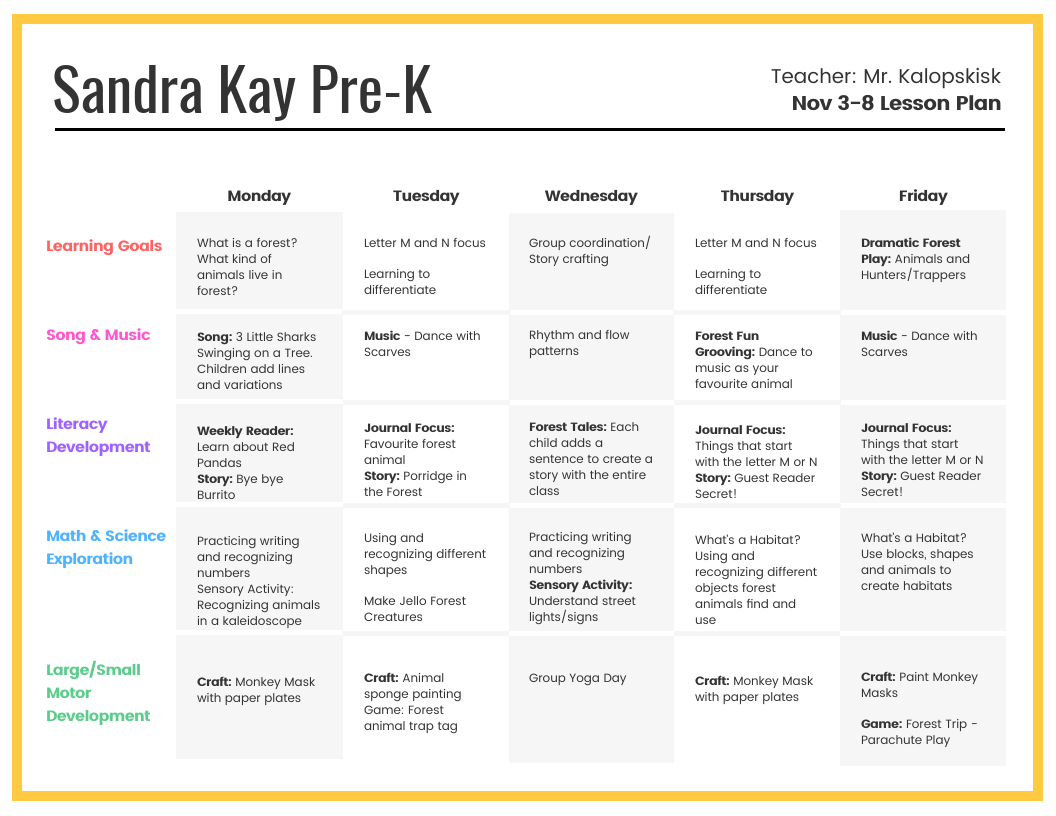
Get an overview of your week with a weekly lesson plan
A weekly lesson plan works great for preschool education planning, as it helps you identify and build lessons around common themes or goals. In the lesson plan template below, weeks have been broken down into different areas of focus.

Use icons in your Preschool lesson plan
Using icons is a great way to communicate visually. Icons are easy to understand, especially when you’re skimming a document.
Take this lesson plan template for example, not only do the icons help communicate the lesson themes, they also make the lesson plan example super engaging and fun.
Using icons can also be a great way to help students who struggle with non-visual learning. For more ways to improve your lesson accessibility, check out this guide to creating a Color Blind Friendly Palette .
Creating a math lesson plan involves careful planning and consideration of various elements to ensure effective teaching and learning. Check out these lesson plan ideas for writing the best math lesson plan, as well as some templates you can edit.
Use pops of color in your lesson plans
Just because your lesson plan tackles a complex subject doesn’t mean it has to be boring. In this lesson plan example a mint green color has been used to help break up the design. You could color code different subjects or units if you have multiple classes to teach.
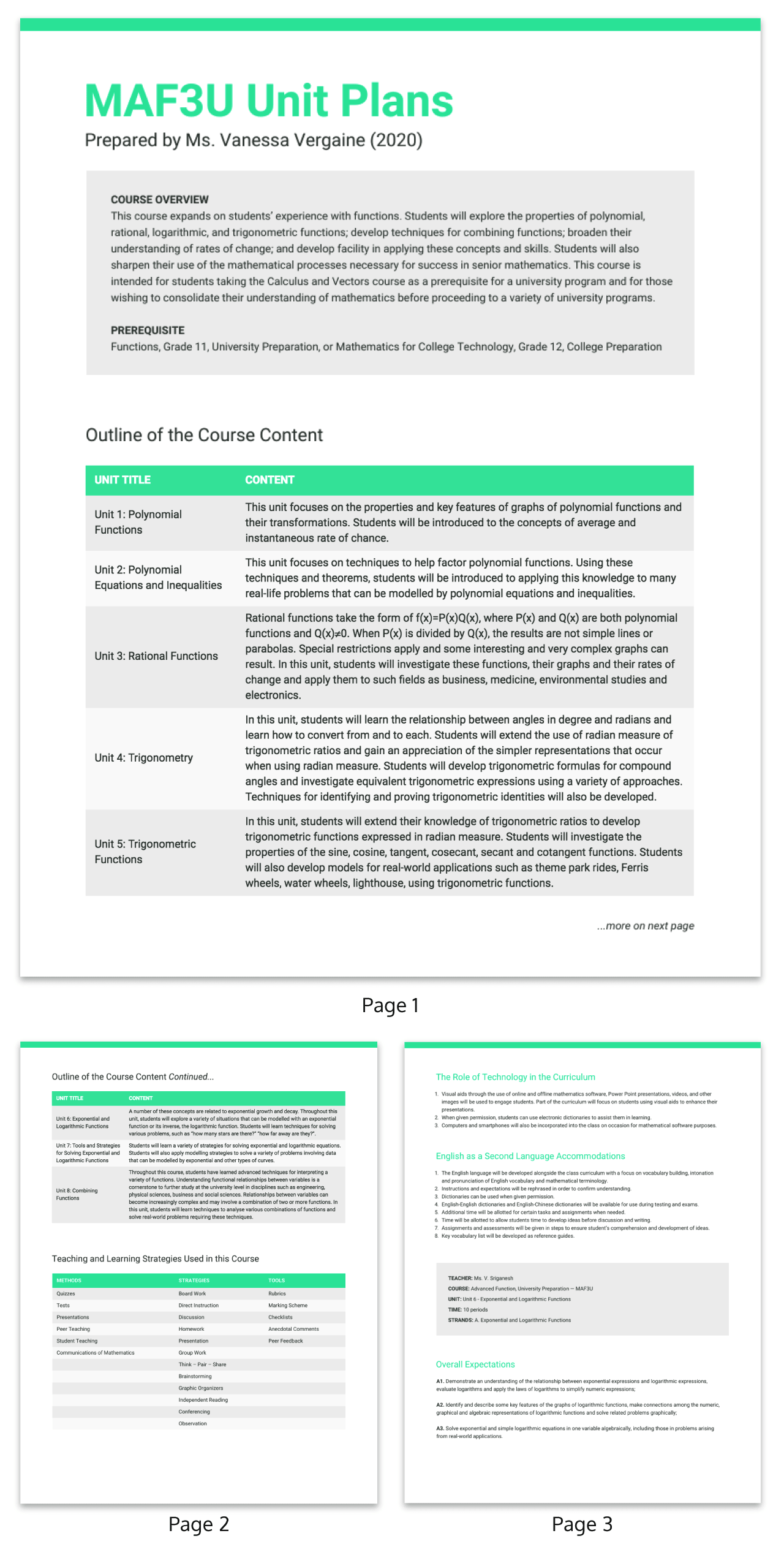
Break your lesson plan into sections to make it easy to follow
Being properly prepared for any eventuality in your lesson starts with good planning. By using sections, like in the lesson plan example below, you can cover all of your bases.
When lesson planning, consider the following:
- Lesson discussion questions
- Activity options for multiple group sizes
- Lesson notes or feedback
In this math lesson plan activity, the teacher has thought through all of the needs of their class.

Think outside the box when lesson planning
When lesson planning, the world, or at least the internet, is your Oyster. Instead of just teaching vocabulary, use scavenger hunts, word searches, or story activities.
Try picking a new activity and building your lesson around that. In the lesson activity example below, Merriam-Webster has a dictionary scavenger hunt that will keep students engaged and entertained throughout your English lesson.

Highlight your lesson objectives at the top of your lesson plan
Your learning objectives should guide your lesson planning, not the other way around.
In this sample lesson plan that focuses on analyzing a film for an English class, the learning objectives are housed within the same section as the lesson plan overview, right on the first page:

If you want to learn how to write an actional learning objective , check out this post on learning objective examples .
Science l esson plan examples
Planning a science lesson can mean anything from experiments to monitoring or diagramming and labelling.
Following a template, like in the science lesson plan examples below, can help make sure that your science lessons run smoothly.
Provide a space for reflection in your science lesson plan
Whilst a lesson plan is a place to schedule your activities, it can also be a great document to refer back to when planning future sessions. Adding a reflection section in your science lesson plan can be a great way to add notes about what worked and what didn’t within your lesson, for future reference.

Break projects down into sections of deliverables
If you’re conducting a difficult lesson, such as a hands-on science project, it can be handy to help yourself and your students by outlining expectations. A checklist can be a great way to make your science lesson plan as effective as possible.
In this lesson plan example, the deliverables have been broken into easy-to-follow checklists.

Use illustrations to bring your lesson plan templates to life
Your lesson plans should inspire you, not bore you! Using illustrations is a great way to bring your lesson plans to life.
In this sample lesson plan, the teacher has used colorful and playful illustrations to reflect the content of the lessons.

When creating Elementary school lesson plans, you need to make sure that you’re keeping a good overview of many different subjects at once.
Having a clear, easy to understand Elementary lesson plan, like in the examples below, is really important for making sure that all your learning objectives are being met.
Break your elementary lesson plans into day and subject sections
Elementary students will often be studying various topics and subjects at once and keeping an overview of this can be difficult. By creating a weekly lesson plan you can make sure that your students stay on track.
In this lesson plan template, subjects and activity have been split across the days, with simple summaries of each section within the lesson plan.

Include notes sections in your lesson plans
Planning a lesson is important, but reflecting on a lesson is essential. Adding notes sections to your lesson plans, like in this weekly lesson plan example, is a great way to remind yourself to evaluate as you go.
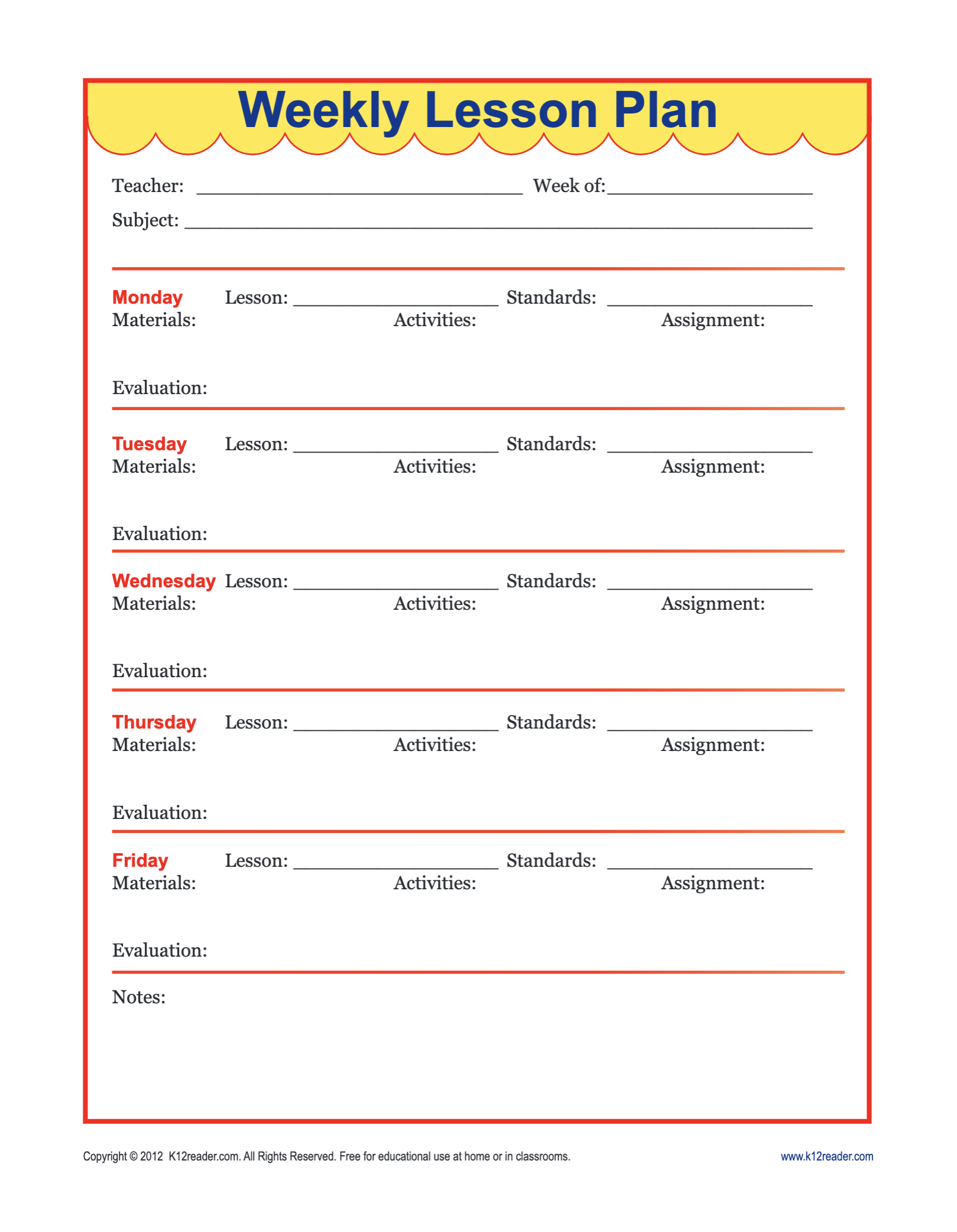
Evaluating yourself and your lessons can be a daunting task. Applying various evaluation strategies, such as a SWOT Analysis , is an easy way to give your evaluations focus.
Creating a high school lesson plan involves a more structured approach, as students at this level are typically engaged in more advanced academic subjects.
Ensuring that your High School lesson plans account for success and reinforcing skills is one way to deliver the best education for your learners.
Include indicators of skill in your high school lesson plans
In high school, lesson plans tend to be more advanced. In the high school lesson plan example below, the teacher has included a section for indicators of skill.
Indicators of skill are a great way to measure your students’ understanding of a topic and can be used to help inform your planning and teaching. Add two or three skill indicators into your lesson plans to ensure you know how to identify which students may need additional support from you in teaching.

You can also scroll back to the Math lesson plans section for more ideas on high school lesson plan templates.
Remember how I mentioned you should include timelines in your lesson plan? Well, for a high school lesson plan, you can include a timeline template like this one to make sure your students understand all the dates required for their school project:

When creating art lesson plans, use bright colors, patterns, icons and graphics to create a truly engaging visual art lesson plan, like in the examples below.
Art lessons lend themselves to creative and visual learning , so your Art lesson plans should be creative and visual as well.
Incorporate learning examples in your art lesson plans
Art lesson plans can be one of the most fun to create. Art as a visual medium lends itself to an exciting and decorative lesson plan.
In the art lesson plan example below, the teacher has inserted visual examples to use during the lesson directly into their lesson plan. Collecting all of this information in one place means that you can quickly refer back to your lesson plan mid teaching.

Be creative with your art lesson plan design
If you’re creating an art course, you’re probably a creative person. Why not let that creativity shine in your lesson plan templates?
Fun illustrations and patterns have been used in the lesson plan sample below to create a visually appealing lesson plan design.

When picking colors for your lesson plan design, some schools will need to be aware of color connotations. Certain colors should be avoided due to gang or rivalry associations. Some schools will also want to ensure that all materials produced fit within your school colors.
Use colors and patterns in your art lesson plan designs
As well as colors, patterns can be used, like in this art lesson plan example, to create interest in your lesson plan design.
Picking a patterned but simple background is an easy way to add depth to any lesson plan design.

When creating middle school lesson plans, like in the templates and examples below, it’s important to focus on success and simplicity.
Middle school is a time for make or break for many learners. Skills that they learn in middle school carry them through life and it can be a huge weight to carry. But teaching middle school can also be incredibly rewarding. Here are some tips to help you create an effective middle school lesson plan:
Make note of what success looks like in your lesson plan
In teaching, quite often the end goal is not for the students to just arrive at the correct answer, but to understand the process of getting there. Having this mentality in your mind whilst lesson planning is an excellent way to ensure your students are learning effectively and that you are maximizing your teaching impact.
Add a section to your lesson plans as to what success looks like for you and your students like in the Middle School lesson plan template:

Color code your lesson plan for ease of use
Colors can be a great differentiator in content and color-coding your lesson plans is a great way to make information pop. In this lesson plan example, each day has a different color which makes planning and evaluating much easier.

Related Reading: What Disney Villains Can Tell Us About Color Psychology
Creating simple lesson plans involves breaking down the content into manageable components and incorporating straightforward activities.
Sometimes simple is best—especially when it comes to lesson planning. When you’re panicked mid-teaching, having a simple and straightforward lesson plan that you can take a quick glance at it can be invaluable.
Keep your lesson plan simple for stressful situations
When performing under pressure, staying simple is usually the best option. Using a clean and modern lesson plan design is one way to ensure that you can stay focused on what matters: teaching.
Simple doesn’t have to mean boring, though. Using good design principles and following one or two graphic design trends means that your simple lesson plan template can still look smart.

Use an icon to help differentiate different subject lesson plans
Icons are an easy way to differentiate your lesson plans by subject or topic. In the lesson plan example below, a large book icon has been used at the top of the page so that you can quickly see that this is an English lesson plan.
You could use an icon for each subject you teach, or use icons to tell a story . You could even replace the icon with a photo of your lesson materials!

Use an action plan approach in your lesson planning
In the simple lesson plan example, the tasks in the lesson plan have been labeled as an “action plan” . By keeping the lesson plan design simple, the focus is really on the content of the lesson plan.
Creating an action plan when teaching your lessons is a great mindset for creating engaging lessons and proactive teaching.
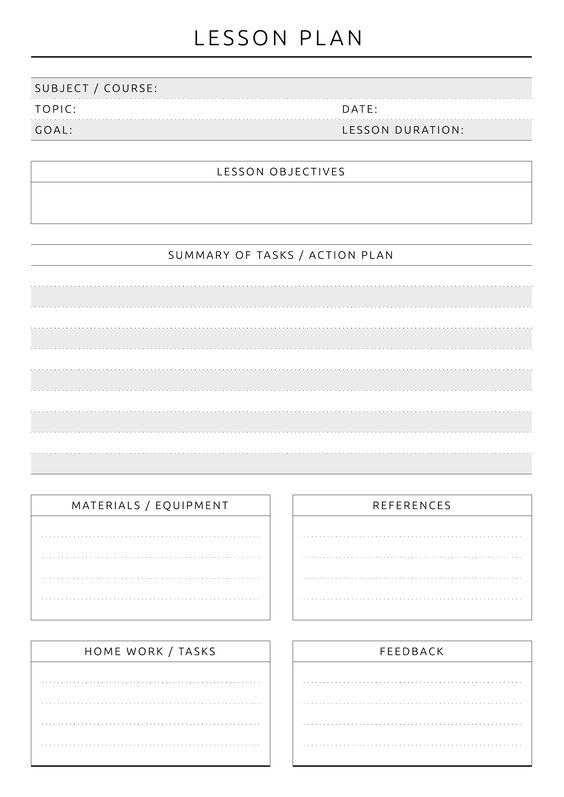
Creating an English lesson plan is the best way to keep track of all the learning strands and activities that are needed for learning success.
Imagination, drama, romance and tragedy. English lessons have it all. But they can also be complicated to teach, with many moving parts to any one lesson.
Like you’ll see in the English lesson plan examples below, creating engaging activities to a strict time schedule is perfectly possible with enough planning.
Use your lesson plan to schedule each activity by the minute
Any teacher will know the feeling of reaching the end of your material with 10 minutes left in the lesson.
Avoid running short (or running over!) in your lessons by planning down to the minute. The English lesson plan example below measures out timings for each activity so you finish perfectly on time.
You can use a timer on your interactive whiteboard , or get students to time themselves. Scheduling is a great skill to incorporate into any lesson plan.

Creating a history lesson plan is essential for a successful session no matter if you’re teaching the near past or the ancient history.
Using common teaching resources such as timeline infographics , or imaginative play and learning are exciting ways to make your History lesson plans exciting.
Prepare for history lessons with a history timeline infographic
Teaching history effectively and engagingly relies on the teacher’s ability to bring the past back to life. For some students, mentally visualizing history can be difficult. A timeline infographic is a great way to teach historical events.
When planning your history lesson, make sure you have all of your timelines sorted. You can either prepare your history timelines in advance or get the students to create their own history timeline as part of the lesson activity.
Venngage has a whole range of timeline infographic templates that are easy to customize.

Want to learn more about how to create a timeline infographic ? Check out the video below:
Use themes and historical events to enrich your lesson planning
When planning your history lessons, look for topical themes or historical events that you can anchor your lesson plan around.
In the lesson plan example below, the teacher is using Black History Month as an anchor point for their students’ learning.

Teaching the historical significance of Black History Monthand engaging students in related learning activities throughout February is a great way to contextualize current affairs. There are plenty of resources online to help create your Black History Month lesson plans.
Related Reading: Looking for other global holidays and events to theme your lessons on? Check this Ultimate List of Holidays .
Creating a kindergarten lesson plan involves similar principles to those used for preschoolers but with a bit more structure and focus on foundational academic skills.
We all know that meme “teaching kindergarten is like using a blender without a lid”. Staying organized is super important and having thorough easy-to-follow kindergarten lesson plans is one way to make sure your teaching stays on track.
Use themes to help plan your Kindergarten lessons
Help your kindergarteners embrace learning by using themes to plan their education. Themes are a great way to work through lots of different learning activities under one thematic umbrella.
This kindergarten lesson plan example uses St Patrick’s Day as its thematic anchor and bases Math, Art, Science and more off of one common theme.
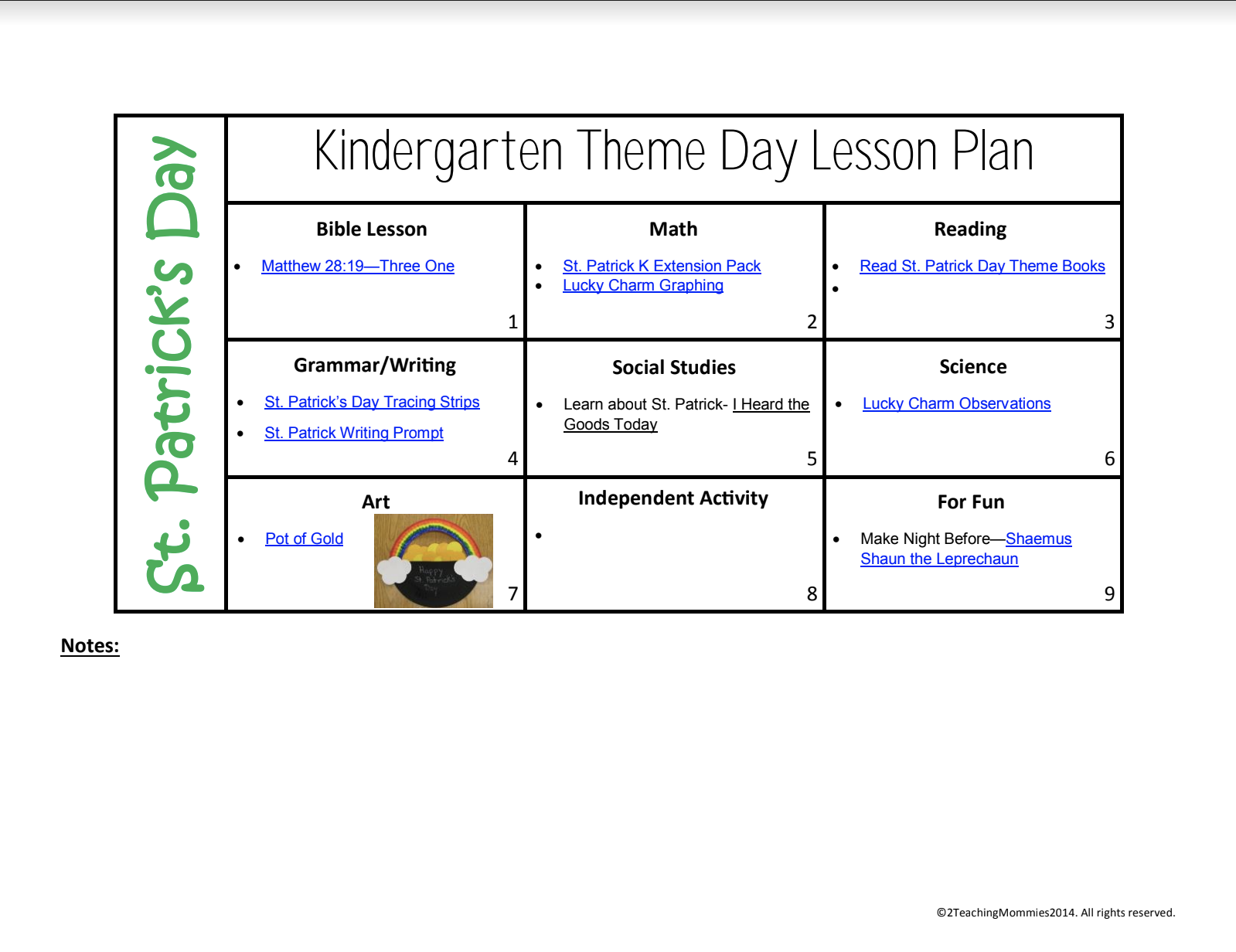
Make your lesson plans easy to skim
We’ve all been in a spot when our mind goes blank and we need to quickly refer back to our lesson plan. Especially if you’re interviewing or teaching in front of others.
By making your lesson plans easy to skim, you can quickly regain your train of thought and continue conducting a successful lesson.
In the sample lesson plan below the teacher has used simple blocks, checklists and icons to help ensure their lesson plan is easy to understand at a glance.

When creating eLearning , distance learning, remote learning, digital learning lesson plans—basically, anything outside the usual classroom setup—always be ready for its own set of unique challenges.
Engaging learners from behind a screen, or creating lessons that can exist outside of a traditional classroom environment can be difficult. But proper eLearning lesson plans can help you navigate non-traditional learning environments.
Break your eLearning lesson plan into activities or subjects
With so many people shifting to remote or digital learning keeping track of all of your separate subjects can be difficult. Creating an eLearning lesson plan that is broken into smaller chunks, with space for each topic, is an easy way to keep learning on track.
In this eLearning lesson plan example subjects are color coded and broken into small blocks.

For more examples of eLearning lesson plans, check out this post on course design templates .
Looking for more eLearning resources?
- 7 Ways to use eLearning Infographics
- Digital Learning Communication Resources
- What is an Infographic?
- 10 Types of Visual Aids for Learning
Use a daily schedule when learning remotely
Learning remotely can be a big change for both teachers and students. One way to keep your learning on track is with an easy-to-follow daily schedule. Using a daily schedule as a lesson plan, like in the example below, is one way to maintain a routine during difficult times.

As well as scheduling within your lesson plan, you can also create a calendar to help keep your students on track.
Allow time for creativity and fun in your lesson plans
One of the biggest benefits of eLearning, Remote Learning and Digital Learning is that you can stray from the confines of a traditional classroom.
Giving students the opportunity to explore topics creatively can be one way to engage your learners in difficult times. Every student will have a different learning style and by scheduling structured creative learning activities you can ensure that your entire class has the opportunity to thrive.
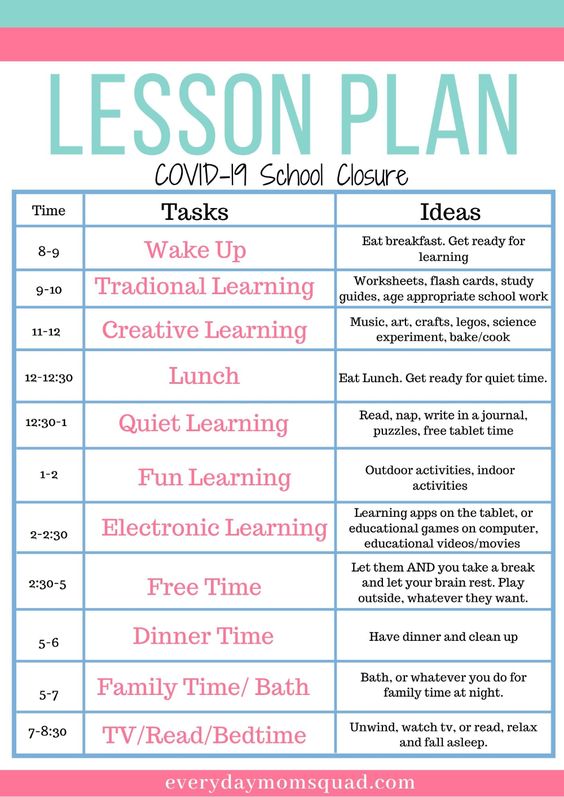
To sum up: Use a lesson plan template to write an actionable and easy-to-follow lesson plan
Writing a lesson plan from scratch can be difficult, which is why Venngage has created tons of lesson plan templates you can edit easily. You can also draw inspiration from the different lesson plan examples in this post to customize your lesson plan template.
Simply create a Venngage account, pick the template you want and begin editing. It’s free to get started.

IMAGES
VIDEO
COMMENTS
The common ground of fiction and non-fiction writing is the creativity the writer uses to express his or her thoughts and emotions. The following examples show that, to some degree, all writing is creative, since it always involves re-creation, ie. the selection of some components, imagined or real, and exclusion of others. 1.
An easy lesson plan for creative writing that will pay off later is to activate prior knowledge. Brainstorm creative, memorable, unforgettable stories with students. Share your thoughts too! You will start to build relationships with students who share the same tastes as you (and those that are completely different!).
The "I Remember" Poem. Students use personal experience to write creatively in this poetry lesson plan. They'll think back and choose a dozen…. Subjects: Reading and Literature. Poetry. Creative Writing. Download. Add to Favorites.
First, please remember that any teacher can use these creative writing lessons. You don't need to be teaching homeschoolers. You can be a classroom teacher or a homeschool teacher at home with one student. You can even be a librarian who needs a fun program series. Second, I used these creative writing lesson plans with upper elementary ...
Here's How to Teach a Creative Writing Activity to Elementary Students: 1. Start with Creative Writing Prompts. One of the first activities you can try is using writing prompts with students. Writing prompts are a great tool to get students' brain juices flowing, no matter if they are elementary, middle school, or high school students!
Creative Writing Lesson Plan Instructor Dana Dance-Schissel Show bio. ... Introduction to Psychology: Tutoring Solution View Lessons (255) Nutrition 101: Science of Nutrition
Cite this lesson. Recognizing different types of creative writing is the first step in teaching your students how to write creatively. Use this lesson plan as a starting point in introducing many ...
Teach students to treat self-editing as a separate stage in the writing process. get students reading in the genre they'll be writing; e.g., if they're writing poetry, encourage them to read a lot of poems. help students learn to trust their own perspectives and observations, to believe that they have something interesting to say.
A flexible creative writing lesson plan supports all the writing genres, from narratives to poetry (and everything in between!). Whether you're looking for quick, usable ideas to help your students compose stories, biographies, personal or business letters, reviews and editorials, essays or poetry, browse through the links below.
In the middle school world, non-fiction is the primary focus of classroom writing. Therefore, a creative writing unit can provide a breath of fresh air. This unit guides students through a step-by ...
Overview. To promote development, detail, and focus of ideas in students' writing, it sometimes helps to start with a fun, creative writing activity that encourages what you want to see in all of their writing. In this minilesson, students practice writing detailed, sensory-rich descriptions by framing a small piece of nature and freewriting ...
Ideas for a Creative Writing Course Plan Creative Writing Lesson Plans and Activities Primary/Elementary School ... Combine the project with an art lesson, asking students to include photographs or drawings of their past experiences. Base the size of the project on
1. Education.com offers creative writing lesson plans to kids of all ages. Teachers will find our lesson plans spark their classroom's imagination into artistic storytelling and writing. Our lesson plans are all purposefully themed so children can think outside the box when applying creative writing concepts. Don't delay the creativity - start now!
A SEMI-DETAILED LESON PLAN IN CREATIVE WRITING (GRADE 12) August 30, 2022 ... II. SUBJECT MATTER Topic: Introduction to Creative Writing Reference: John Oliver M. Ramos, J. M. (2017). Fundamentals of Creative Writing. Brilliant Creation Publishing, Inc.. ... Lesson PLAN IN Creative Writing - WEEK 1. Course: philosophy of human being (2020)
Content Area:English as a second language. Procedure: 1. Introduction on creative writing is to be given to students as they have no previous knowledge of the topic. 2.As a warm up activity, students will be asked to attempt free writing on a given topic. This will create confidence in them that they can attempt writing tasks.
Introduction to Creative Writing is a hands-on, interactive exploration of nonfiction, poetry, playwriting, and fiction. Students will read examples from each genre and discuss the craft elements demonstrated in each text. We will then go on to try our own hand at drafting and revising essays, poems, plays, and prose.
Writer's block is the inability to write because the writer doesn't know what to write, doesn't know how to proceed in a piece of writing, or doesn't have the confidence to write. The condition can last for several minutes to days to weeks, and even months and years for some writers. Often, the inner critic, a still, small, critical ...
Characters, setting, plot, conflict, point of view, and theme are six key elements for writing fiction. Characters. Characters are the people, animals, or aliens in the story. Readers come to know the characters through what they say, what they think, and how they act. E. M. Forster, an English novelist, identified that characters are either ...
The Writing Process. Lesson 1: Writing Preferences and The Writing Process. Exercise 1: Identify Your Writing Preferences. Lesson 2: Writer's Block. Video: Writer's Block Instant Cure. Exercise 2: Your Experience with Writer's Block.
This lesson is a fun way to introduce students to the world of creative writing! You will need to create or find 10-12 fun writing prompts to use alongside it. ... Creative Writing Introduction Lesson Plan
Keep your lesson mini: A mini lesson is 15 to 20 minutes long and organized in a gradual release format, and it allows the teacher to model a specific, focused lesson. For example, narrative writing could be broken into the following mini lessons for a beginning-of-the-year cycle for second grade: introduce and describe a setting, introduce and ...
Lesson plans are maps, mission statements, launching pads, and contracts. Lesson plans help keep everyone working together toward the common goals of learning and understanding. When lesson plans are well crafted and executed, the classroom functions smoothly. When lesson plans fall short, learning comes to a grinding halt.
1. Set your objective for the lesson. At the beginning of every lesson, write your lesson plan goal at the top. The objective should be one sentence, contain a strong verb, and communicate what students will know or be able to do by the end of the lesson.
Objectives: know your destination. When writing a lesson plan, start by outlining the learning objectives—what you want your students to take from the session and work backward. Having clear and specific goals helps you plan activities for a successful lesson. 2. Welcome to the hook: make 'em want to learn.